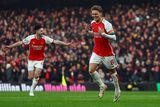Trent Alexander-Arnold: What does Jurgen Klopp need to do to get the best out his world-class player?
Liverpool's Trent Alexander-Arnold celebrates Photo: Peter Byrne/PA
Trent Alexander-Arnold has never scored twice in a game for Liverpool. He probably thought he had by the end of their wild 4-3 win over Fulham, but as it turns out, his first – a magnificent free-kick which struck the bar and went in – went over the line via the back of Bernd Leno, the goalkeeper credited with an own goal as a result. Continue this way, though, and a first brace won’t be far away.
There was, however, no doubt about the No. 66 seeing his name on the scoresheet after 88 minutes, sealing the comeback victory and three important points in the process with a fizzing strike on the turn from the edge of the box.
His all-round attacking impact on the game and the fact he netted the winner – three additional points earned now by his goals across the Reds’ last two league outings – will only add to the argument that Jurgen Klopp must move his vice-captain up from right-back into central midfield on a regular, permanent basis.
Perhaps the manager will argue that the 25-year-old is already getting into advanced, effective positions while nominally positioned as a defender, too, but his match-winning effect against Fulham came after a deliberate reshuffle by Klopp to put him centrally, in a double pivot, as the Reds chased first a draw and then the victory.
Many considerations, then, but also a lot of potential avenues to explore as Liverpool seek to move towards a resolution over Alexander-Arnold’s best role in future. Firstly, they can merely continue the status quo. Klopp hasn’t been in a hurry to make Trent a midfielder from the start, with just the odd cup outing seeing him in a different spot on the initial teamsheet. Alexander-Arnold drifting into the middle from right-back works in build-up play, if not always increasing team cohesion in defensive and transition phases, but the option remains – like against Fulham – to change things from the bench in-game.
A move forward for the Scouser has perhaps three further branches to it, and each brings a knock-on effect question mark: if Alexander-Arnold is no longer right-back, who is? Joe Gomez has been largely impressive in that role this season but does not offer the creativity or range of passing into the final third his team-mate does.
Nor does it feel likely that someone else going there permanently would be asked to do the same role Alexander-Arnold does now – Liverpool would, from a tactical perspective, require something different from a full-back outlet rather than doubling up on what Trent would then be doing from a midfield spot.
So would Liverpool need to delve into the transfer market? Are young pair Conor Bradley and Jarrell Quansah considered far enough along to become first-team regulars?
Finances have rarely been splashed out too frequently or at short-notice mid-season at Anfield, and first-team, elite-level full-backs do not tend to come cheap, even if a potential list of candidates does already exist and an altered tactical plan is in the works at the Kirkby Training Centre.
Right-back aside, Trent’s role in the middle is not fully defined at present, either.
He has a handful of times become the No. 6 in Klopp’s usual trio, sitting at the base to use that passing range to good effect from space – but when moving in the middle from right-back, he’s a roving, rampaging sidekick to the sitter, the player with more scope to switch channels through his movement as well as his changes of play.
Not to mention that big talking point of goalmouth action: as the deepest player, can Liverpool afford for him to surge forward and be the goal threat he clearly is? Not with two aggressive No 8s ahead of him, not if they want to be far more solid defensively than they were against Fulham. On the other hand, Alexis Mac Allister is not in his best role as a No. 6 right now; would pushing both players one step forward benefit the team overall?
As an eight himself, there’s reason to like what Alexander-Arnold might offer, but it’s a huge role change. But against Fulham, when he had his winning impact, it didn’t come from the usual alignment: it came instead after the manager had chopped and changed to a two-man midfield, Wataru Endo – who scored the equaliser, also able to stride forward – providing balance when Trent pushed on and offering a covering, holding player to provide a platform and a semblance of structure for the four or five in attack.
Given Klopp’s history, so far, of tweaks, and most importantly, finding a winning combination, it would be no surprise to see yet another tiny twist to Liverpool’s layout. Wherever he ends up and however Alexander-Arnold is used game-to-game, the one thing which does look certain is that as a central cog in the team, the current Liverpool right-back will only continue to have an even greater influence as a world-class player of game-defining quality.
.jpg)


.jpg)
.jpg)
.jpg)







.jpg)

